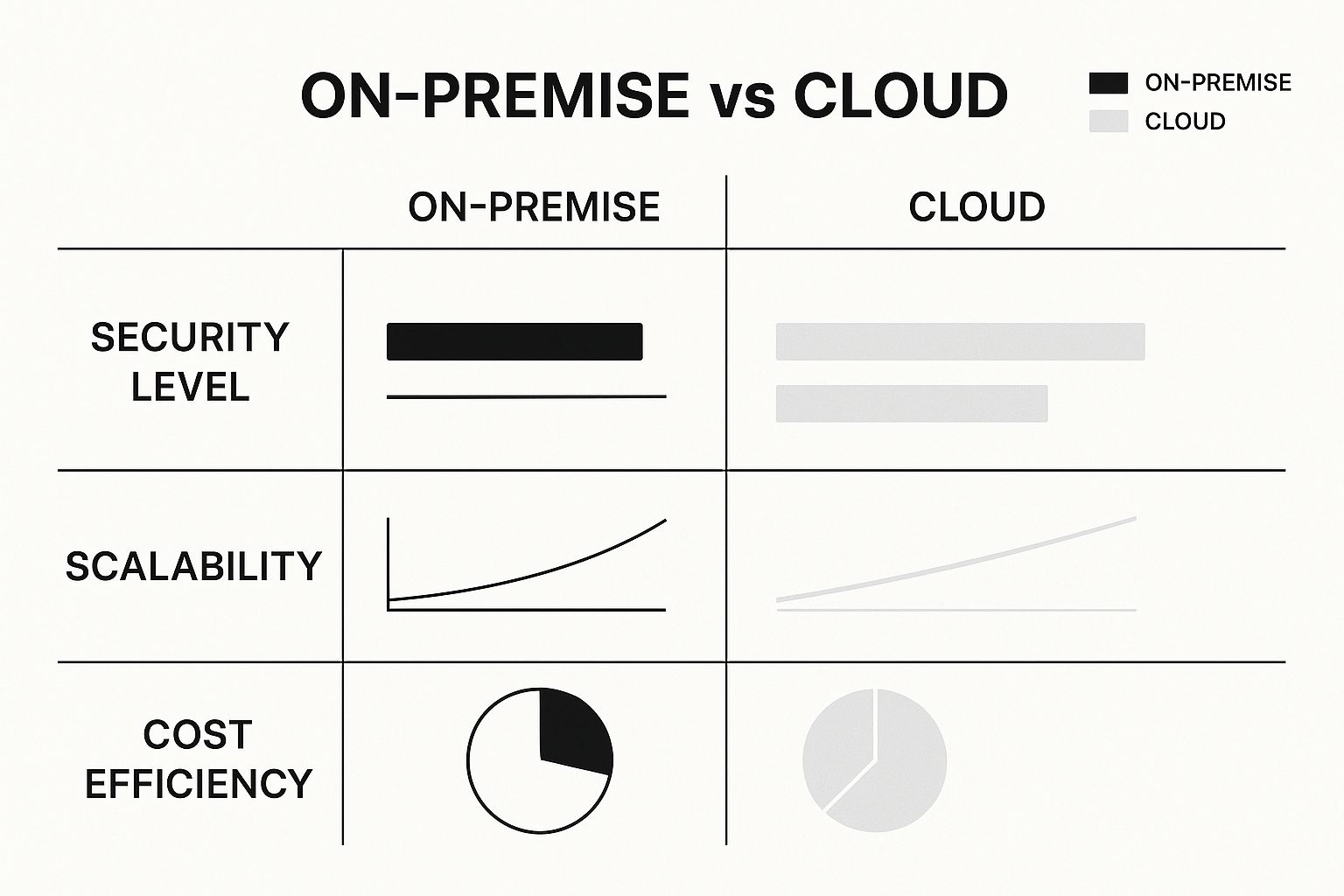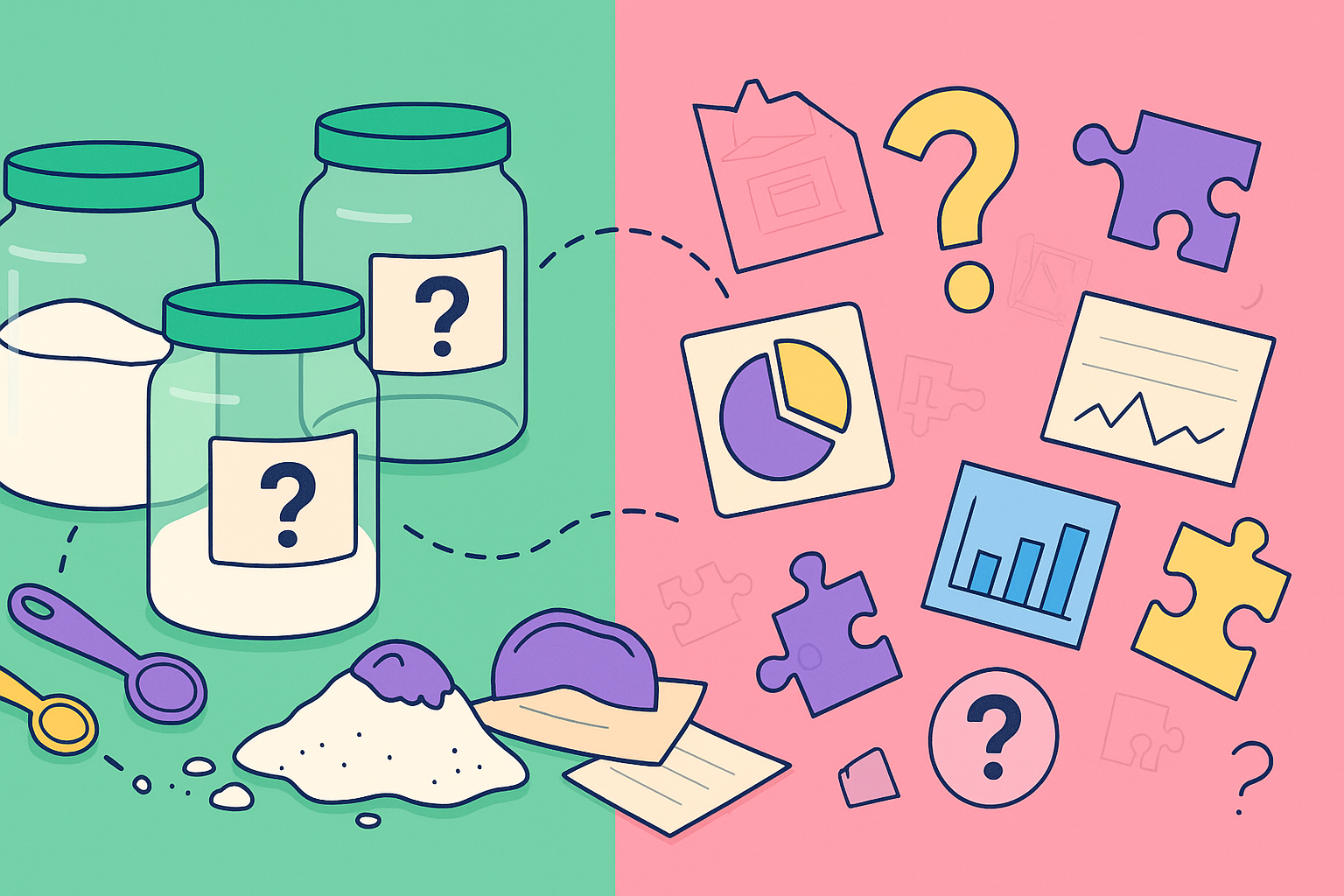Think of it this way: you wouldn’t try to bake a cake with a pantry full of unlabeled jars. Is this flour or salt? Sugar or baking soda? Without clear labels, you’re just guessing, and the result is likely to be a disaster. That’s exactly what running a business is like without solid customer data management. You have all these pieces of information, but without organization and context, they’re messy and almost useless.
What Is Customer Data Management, Really?
At its core, customer data management is the system you use to gather every piece of information your customers share with you—from website visits and purchases to support tickets and social media comments—and bring it all together into a single, understandable profile. It’s the process of turning a chaotic mess of raw data into a genuine business asset.
It’s the Bedrock of Modern Business
Let’s be clear: managing data isn’t just a technical chore for the IT department anymore. It’s a fundamental business strategy. You can see this shift in the explosive growth of tools like Customer Data Platforms (CDPs). In fact, the CDP market grew at a compound annual rate of nearly 17% between 2020 and 2024. This isn’t just a random trend; it’s a direct response to the end of third-party cookies and a greater focus on privacy, forcing businesses to get much, much better at handling the data they collect themselves. You can read more about the CDP market’s expansion on dinmo.com.
The ultimate goal here is to create a single, reliable source of truth for every single customer. When your marketing, sales, and support teams are all working from the same playbook, the customer experience feels connected and consistent.
A business that fails to manage its customer data is essentially flying blind. It can’t anticipate customer needs, personalize communication, or build the loyalty that leads to sustainable growth.
This unified view gives you a complete picture of the entire customer journey. You can see the very first time someone landed on your site, what they clicked on, what they bought, and every support ticket they’ve ever filed. This holistic perspective is the key to unlocking real insights and making smarter decisions across the board.
Understanding the Types of Customer Data
To get this right, you have to understand that not all data is the same. A smart data strategy means collecting and sorting different kinds of information, because each one tells you something unique about your customer.
Thinking about data in categories helps you figure out what you need to collect and why it matters. Here’s a simple breakdown of the four core types.
The Four Core Types of Customer Data
| Data Type | Description | Examples |
|---|---|---|
| Identity Data | The basic, foundational info that tells you exactly who a customer is. | Name, email address, phone number, physical address, social media handles. |
| Descriptive Data | Contextual details that add color and describe a customer’s life or work. | Job title, company name, industry, family size, income level, education. |
| Quantitative Data | The hard numbers—measurable actions and interactions a customer has with you. | Number of website visits, purchase frequency, items in cart, support tickets opened. |
| Qualitative Data | Subjective information that reveals opinions, feelings, and motivations. | Survey responses (“How was your experience?”), product reviews, support chat transcripts. |
Each of these data types provides a different piece of the puzzle. When you bring them all together, you move from having a flat, one-dimensional sketch of your customer to a rich, three-dimensional portrait.
Navigating Common Customer Data Roadblocks

While the goal of a single customer view sounds fantastic in theory, the journey to get there is usually littered with obstacles. Many businesses find themselves in a strange paradox: they’re drowning in data yet somehow starving for real, actionable insights. This disconnect almost always comes down to a few common, but major, roadblocks in customer data management.
Think of your marketing, sales, and support teams as operating on separate islands. Each team has its own tools, its own processes, and its own treasure chest of customer information—but they rarely, if ever, share it. This is a classic case of data silos, and it’s one of the biggest hurdles to clear.
When your customer information is scattered across a CRM for sales, an email platform for marketing, and a helpdesk for support, getting a complete picture is next to impossible. For instance, SMB sales teams use an average of 10 different channels to talk to customers. That’s not a unified system; it’s a tangled web of disconnected facts that makes a single customer view feel like a pipe dream.
The Problem of Disconnected Data
The fallout from data silos isn’t just a minor inconvenience; it’s genuinely damaging. Your marketing team might send a promotion for a product a customer already bought last week. Or a sales rep, completely in the dark, might call a customer who just had a frustrating experience with support. These aren’t just mix-ups. They erode trust and make your company look disorganized.
Without a central source of truth, you end up creating choppy, disjointed customer journeys. Every new interaction feels like starting from scratch, forcing customers to repeat themselves and leading to massive frustration. This fragmentation is the direct enemy of the seamless, personal experiences that build loyalty and grow revenue.
In a world where 80% of customers say their experience with a company is just as important as its products, a fragmented data strategy isn’t just a technical problem—it’s a direct threat to your bottom line.
The High Cost of Poor Data Quality
Let’s say you do manage to break down the silos. You’re not out of the woods yet. Another poison can seep into your system: poor data quality. This “dirty data” comes in many forms and can quietly sabotage all your hard work. It’s like trying to navigate with a faulty compass—the information looks plausible, but it’s leading you completely astray.
Common data quality culprits include:
- Duplicate Records: Multiple profiles for the same customer create confusion and often lead to annoying, redundant communications.
- Incomplete Information: Missing phone numbers, job titles, or company details make it incredibly hard to segment your audience or even contact them effectively.
- Outdated Data: People change jobs, move cities, and get new email addresses. Using stale information means bounced emails and wasted effort.
- Inconsistent Formatting: A lack of standards (e.g., “USA” vs. “United States”) makes accurate analysis and reporting a nightmare.
This bad data doesn’t just sit there innocently. It actively causes harm, leading to flawed analysis, misguided marketing campaigns, and ultimately, terrible business decisions. Cleaning and maintaining data isn’t a one-and-done project; it’s a continuous commitment required for reliable insights.
Security and Compliance Labyrinths
Finally, every business today has to navigate the treacherous landscape of data privacy and security. The risk of a data breach is a constant shadow, and the consequences go far beyond just financial penalties. It’s a sobering thought, but a staggering 56% of business leaders admit their company suffered a data breach involving customer information in the last year alone.
Protecting customer data is non-negotiable. With regulations like GDPR and CCPA now in place, businesses are legally bound to handle personal information with extreme care. This means:
- Securing Data: Implementing strong encryption and access controls to keep bad actors out.
- Ensuring Compliance: Following strict rules on how data is collected, used, and stored.
- Building Trust: Being transparent with customers about how you handle their information.
A failure on this front can destroy your company’s reputation overnight. A single security incident can wipe out years of hard-won customer loyalty. Robust security isn’t just a feature; it’s a foundational pillar of any real customer data management strategy. Tackling these roadblocks is the first critical step in turning your data from a liability into your most valuable asset.
Building Your Customer Data Management Framework

Once you’ve identified the common roadblocks, you can start drawing up the strategic blueprint to navigate around them. A strong customer data management framework isn’t just some technical checklist; it’s a foundational plan for building a truly data-driven culture. This framework lays out the rules, processes, and tools you need to turn chaotic information into a reliable business asset.
Think of it like building a house. You wouldn’t just start throwing up walls and hope for the best, right? You need a solid foundation, a clear architectural plan, and quality materials. Your data framework does the same thing, ensuring every piece of customer information is collected, stored, and used in a way that’s organized, secure, and genuinely valuable.
It all starts with defining the rules of the road—how data will be handled across your entire organization.
Establish a Clear Data Governance Policy
Data governance is the essential first step. This is the formal policy that spells out who owns the data, who can access it, and what standards it must meet. Without governance, you’re basically inviting the very data silos and quality issues you’re trying to solve. It’s your internal lawbook for all things data.
A solid governance policy clearly outlines:
- Data Ownership: Assigning specific teams or people to be responsible for certain data sets (e.g., the marketing team owns all campaign data).
- Access Controls: Figuring out who can view, edit, and use customer data, based on their role. This is non-negotiable for security.
- Quality Standards: Defining what “good” data actually looks like, including required fields and consistent formatting.
- Security Protocols: Laying out the mandatory procedures for protecting data from breaches or unauthorized access.
This isn’t about creating pointless bureaucracy. It’s about establishing accountability and consistency, which are the absolute cornerstones of trustworthy data.
A data governance policy transforms customer data management from a chaotic free-for-all into a structured, reliable business function. It ensures everyone is playing by the same rules, which is the only way to build a system you can actually trust.
Create a Single Source of Truth
With your governance rules in place, the next mission is to create a single source of truth (SSOT). This is the holy grail of any customer data management strategy: a centralized, unified view of every single customer. An SSOT pulls together information from all your separate systems—your CRM, e-commerce platform, support desk, and marketing tools—into one complete profile.
Achieving this unified view is a total game-changer. It means your support team sees a customer’s recent purchases, and your sales team knows about their open support tickets. This unified data is what powers the consistent, personalized experiences that build lasting customer relationships. For many organizations, the best path forward involves looking into different customer data integration solutions that can effectively merge these varied data streams.
To really build out a robust framework, you’ll also need to dig into essential topics like customer data integration best practices to ensure a smooth, seamless flow of information.
Prioritize Ethical Data Collection and Quality
How you collect data is just as important as how you manage it. Transparency is everything. Being upfront with customers about what information you’re gathering and why builds trust. Regulations like GDPR and CCPA have made this a legal requirement, but honestly, it’s also just good business.
Alongside ethical collection, you have to commit to maintaining data quality. This isn’t a one-and-done task; it’s an ongoing process. It involves:
- Data Cleansing: Regularly scrubbing your database to remove duplicates, fix typos, and correct inaccuracies.
- Data Enrichment: Adding third-party data to your existing profiles to get more context, like adding a job title or company size to a contact record.
- Data Validation: Putting checks at the point of entry (like on a web form) to make sure new data is clean from the very start.
This diligence is what ensures your business insights are based on accurate, up-to-date information, not guesswork. The explosive growth of tools built for this, like Customer Data Platforms (CDPs), really highlights how critical this is. The global CDP market was valued at around $7.4 billion in 2024 and is projected to shoot up to a staggering $23.98 billion by 2029. This boom is fueled by the relentless need for clean, unified data to power better customer experiences.
Choosing Your Customer Data Management Toolkit
Picking the right tools for customer data management can feel like trying to build an orchestra from scratch. You know you need different instruments, but choosing the wrong one can throw the whole performance out of tune. The real goal is to build a technology stack where every piece works together in perfect harmony.
At the center of any modern toolkit, you’ll usually find a Customer Data Platform (CDP). Think of the CDP as the conductor of your data orchestra. It doesn’t replace the individual instruments—your CRM, analytics tools, and so on. Instead, it makes sure they’re all playing from the same sheet music by pulling data from every source and unifying it into a single, cohesive customer profile.
CDP vs CRM vs DMP: A Quick Comparison
It’s easy to get lost in the alphabet soup of data technology. The acronyms—CDP, CRM, and DMP—are often tossed around interchangeably, but they have very different jobs. A Customer Relationship Management (CRM) system is your go-to for managing direct interactions with people you already know. A Data Management Platform (DMP), on the other hand, is built for advertising, working mostly with anonymous data.
A CDP sits right in the middle, designed to bring all your data together—both known and anonymous—to create a persistent, complete view of each customer. Understanding the key differences is the first step toward building a toolkit that actually fits your business.
| Feature | Customer Data Platform (CDP) | Customer Relationship Management (CRM) | Data Management Platform (DMP) |
|---|---|---|---|
| Primary Goal | Create a single, unified profile of each customer from all data sources. | Manage direct relationships and interactions with known customers and leads. | Segment anonymous audiences for targeted digital advertising campaigns. |
| Key Data Type | First-party data (personally identifiable information like emails, purchase history) combined with anonymous data. | Primarily first-party data focused on sales and service interactions. | Primarily third-party and anonymous data (cookies, device IDs). |
| Main Use Case | Deep personalization, customer journey orchestration, and audience segmentation. | Sales pipeline management, customer service tracking, and contact management. | Ad targeting, lookalike audience creation, and media buying. |
Once you can tell them apart, you can start making smart choices about what you really need.
Key Criteria for Evaluating Your Tools
Now that you know the players, you need a way to judge them. Not all platforms are built the same, and what’s best for one company might be a disaster for another. When you’re evaluating your options, keep these five critical areas in mind.
- Integration Capabilities: A tool is only as good as its ability to talk to your other systems. Does it have pre-built connectors for your CRM, email platform, and analytics tools? If it can’t create a seamless flow of data, it’s not the right tool.
- Scalability and Future Growth: Your data isn’t going to shrink. You need a platform that can grow with you, handling more data from more sources without slowing down or breaking.
- User-Friendliness: The most powerful tool in the world is useless if your team finds it impossible to use. Look for an intuitive interface and clean dashboards that let your marketing, sales, and service teams get the insights they need without having to call a data scientist.
- Security and Compliance: With 56% of leaders reporting a recent data breach, this is non-negotiable. Make sure any tool you consider has strong encryption, access controls, and features to help you stay compliant with regulations like GDPR and CCPA.
- Support and Training: Things will go wrong. When they do, you need to know you can get help. Check out the provider’s reputation for customer service, the quality of their training materials, and whether they have an active user community.
Don’t forget to factor in social media insights when you’re thinking about data sources. Using something like a social media analytics report template can help you organize this data before it even hits your main system. And if you want to get a bit more technical, digging into customer data integration best practices can give you a much deeper understanding of how all the pieces should connect.
Lastly, you have to decide where your data will actually live. This infographic breaks down the pros and cons of on-premise versus cloud storage.

As you can see, on-premise solutions give you a ton of control over security, but cloud options almost always win on scalability and cost. For most growing businesses, that makes the cloud the clear favorite.
The Future of Customer Data Management

The world of customer data management isn’t just changing—it’s rocketing into a new era. This future is being built on three pillars: intelligence, speed, and ethics. To keep up, we have to look past today’s best practices and get ready for what’s hurtling our way. At the heart of it all? Artificial intelligence and machine learning are getting woven into the very fabric of how we handle data.
AI isn’t some far-off concept anymore; it’s a hands-on tool that’s completely changing the game. It can automate incredibly complex work, like data cleansing and analysis, on a scale that’s simply impossible for a human team. Even better, AI algorithms can predict what a customer might do next, spot churn risks before they become a problem, and deliver hyper-personalized experiences on the fly. We’re talking about much more than just sticking a first name in an email. This is about knowing what your customer needs before they do and offering the right solution at the perfect time.
The Rise of Flexible and Real-Time Systems
As companies hunt for more agility, the old idea of a single, monolithic data platform is dying out. What’s taking its place is a much more flexible approach. We’re seeing the rise of composable CDPs (Customer Data Platforms), and it’s a huge shift. This model lets companies build their own “best-of-breed” data stack, almost like building with LEGOs. You can pick and choose the specialized tools that are perfect for your business and snap them together into one cohesive system.
This move is fueled by the relentless demand for real-time data. Modern marketing and customer service can’t afford to wait around for nightly batch updates. Businesses have to react the moment a customer acts, whether they’ve abandoned a cart or mentioned you on social media. A responsive, real-time data pipeline is fast becoming the baseline for effective customer engagement and a cornerstone of solid data-informed decision making.
The market is screaming this reality loud and clear.
The Customer Data Platform market is projected to explode, with some analysts forecasting a market value as high as $25.4 billion by 2025. This staggering growth sends a clear message: having a unified, intelligent data strategy is no longer just a nice-to-have.
This boom is driven by industries like retail and finance that live and die by instant personalization. Paired with huge leaps in AI and cloud computing—not to mention evolving privacy laws—the push toward smarter data tech is only getting stronger.
Ethics as a Core Differentiator
Ultimately, the future of customer data management is all about trust. As our methods for collecting data become more and more powerful, ethical handling and data privacy are shifting from a legal checkbox to a core part of a brand’s identity.
The companies that win will be the ones who are transparent and give customers real control over their own data. They’re the ones who will build the strongest, most loyal customer relationships. In this next chapter, how you manage data isn’t just a technical decision—it’s a direct reflection of your company’s values and a critical piece of building lasting loyalty.
Frequently Asked Questions
When you start digging into customer data management, a few practical questions always seem to pop up. Let’s tackle some of the most common ones head-on, so you can move from theory to action with a bit more clarity.
What Is the First Step in a Data Management Strategy?
Before you do anything else, you need to conduct a data audit. It’s a simple but critical idea: you can’t manage what you don’t know you have.
Start by mapping out every single place your business collects customer data. This means your CRM, your website analytics platform, your email marketing tool, your support desk—every single touchpoint. The goal is to see exactly what data lives where and how it’s being used today. This process almost always uncovers hidden data silos, duplicate information, and quality issues, giving you an honest baseline to build from.
How Is Customer Data Management Different from a CRM?
It’s easy to mix these two up, but a CRM is just one tool in the much larger customer data management toolbox. Think of your CRM as the system for managing direct customer interactions—sales calls, support tickets, and email threads.
A true customer data management strategy, on the other hand, is much bigger.
It’s about creating one unified view of the customer by pulling in data from all sources. This includes anonymous website visits, how people are actually using your product, and social media chatter. A Customer Data Platform (CDP) is typically the engine that pulls this all together, while your CRM uses that rich, unified data to make every interaction smarter and more personal.
Can Small Businesses Implement This Effectively?
Yes, absolutely. You don’t need a massive enterprise-grade system to get the benefits. The core principles of customer data management apply to any business, regardless of size.
For a small business, this can start with a few foundational steps:
- Practicing good data hygiene in your current CRM.
- Integrating your marketing tools with your website analytics to connect the dots.
- Creating clear, documented processes for how customer data is handled securely.
The real goal is to build a solid foundation of clean, organized, and accessible data. It doesn’t matter what specific tools you use at first. Getting this right early on means you’re building on solid ground as your business grows.
Ready to tear down the walls between your sales and development teams? resolution Reichert Network Solutions GmbH has the definitive solution. By integrating HubSpot and Jira, you can create a single source of truth that puts real-time customer data right where your teams need it most.
